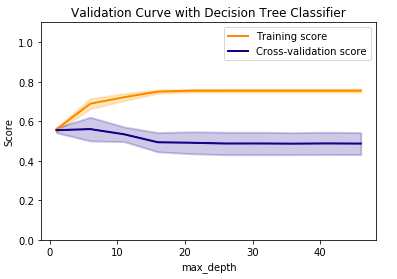I'm trying to see how well a decision tree classifier performs on my input. For this I'm trying to use the validation and learning curves and SKLearn's cross-validation methods. However, they differ, and I don't know what to make of it.
The validation curve shows up as follows:

Based on varying the maximum depth parameter, I'm getting worse and worse cross-val scores. However, when I try the cross_val_score, I get ~72% accuracy reliably:
While I was using the default tree depth for clf here, it still puzzles me how the validation curve never reaches even 0.6, but the cross-val scores are all above 0.7. What does this mean? Why is there a discrepancy?
Code for reference below.
For the Validation curve:
import matplotlib.pyplot as plt
import numpy as np
from sklearn.datasets import load_digits
from sklearn.svm import SVC
from sklearn.model_selection import validation_curve
X, y = prepareDataframeX.values, prepareDataframeY.values.ravel()
param_range = np.arange(1, 50, 5)
train_scores, test_scores = validation_curve(
DecisionTreeClassifier(class_weight='balanced'), X, y, param_name="max_depth", param_range=param_range,
cv=None, scoring="accuracy", n_jobs=1)
train_scores_mean = np.mean(train_scores, axis=1)
train_scores_std = np.std(train_scores, axis=1)
test_scores_mean = np.mean(test_scores, axis=1)
test_scores_std = np.std(test_scores, axis=1)
plt.title("Validation Curve with Decision Tree Classifier")
plt.xlabel("max_depth")
#plt.xticks(param_range)
plt.ylabel("Score")
plt.ylim(0.0, 1.1)
lw = 2
plt.plot(param_range, train_scores_mean, label="Training score",
color="darkorange", lw=lw)
plt.fill_between(param_range, train_scores_mean - train_scores_std,
train_scores_mean + train_scores_std, alpha=0.2,
color="darkorange", lw=lw)
plt.plot(param_range, test_scores_mean, label="Cross-validation score",
color="navy", lw=lw)
plt.fill_between(param_range, test_scores_mean - test_scores_std,
test_scores_mean + test_scores_std, alpha=0.2,
color="navy", lw=lw)
plt.legend(loc="best")
plt.show()
For the cross-val scores:
clf = DecisionTreeClassifier(class_weight='balanced')
X_train, X_test, y_train, y_test = train_test_split(
X, y, test_size=0.33, random_state=42)
clf.fit(X_train, y_train)
y_pred = clf.predict(X_test)
clf.score(X_test, y_test)
UPDATE A comment has been asked about shuffling. When I shuffle the data by
X, y = prepareDataframeX.values, prepareDataframeY.values.ravel()
indices = np.arange(y.shape[0])
np.random.shuffle(indices)
X, y = X[indices], y[indices]
I get:
Which makes even less sense to me. What does this mean?


